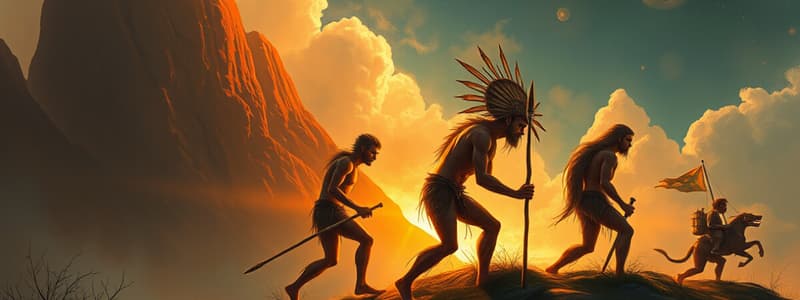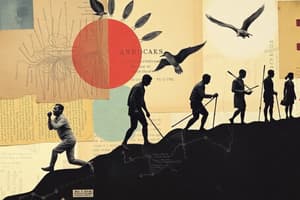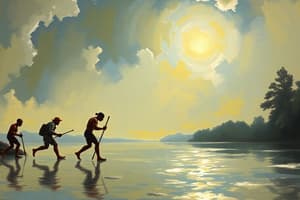Podcast
Questions and Answers
What type of society is characterized by nomadic lifestyles and foraging as the primary food source?
What type of society is characterized by nomadic lifestyles and foraging as the primary food source?
- Hunting and gathering society (correct)
- Horticultural society
- Agricultural society
- Pastoral society
Which period is defined by the practice of sedentary living?
Which period is defined by the practice of sedentary living?
- Neolithic period (correct)
- Age of Metal
- Paleolithic period
- Mesolithic period
Which type of society relies primarily on the rearing of domesticated animals?
Which type of society relies primarily on the rearing of domesticated animals?
- Horticultural society
- Post-industrial society
- Agricultural society
- Pastoral society (correct)
What kind of society is primarily dependent on the cultivation of crops and plants?
What kind of society is primarily dependent on the cultivation of crops and plants?
In which society are permanent tools like plows and trucks used for food production?
In which society are permanent tools like plows and trucks used for food production?
What defines biological evolution?
What defines biological evolution?
Why are humans categorized as nomads during the Paleolithic period?
Why are humans categorized as nomads during the Paleolithic period?
What characterizes the transition from a Hunting and Gathering society to a Pastoral society?
What characterizes the transition from a Hunting and Gathering society to a Pastoral society?
What tool advancements are associated with the Neolithic period?
What tool advancements are associated with the Neolithic period?
How did sedentary living emerge during the Agricultural society period?
How did sedentary living emerge during the Agricultural society period?
What is a critical aspect of socio-cultural evolution?
What is a critical aspect of socio-cultural evolution?
Which society type is marked by the use of limited refined tools and the beginning of animal domestication?
Which society type is marked by the use of limited refined tools and the beginning of animal domestication?
What type of society is associated with the use of advanced metal tools and industrialization?
What type of society is associated with the use of advanced metal tools and industrialization?
What is the primary source of sustenance for pastoral societies?
What is the primary source of sustenance for pastoral societies?
Which technological development marked the transition to industrial societies?
Which technological development marked the transition to industrial societies?
What major societal shift occurred during the industrial revolution?
What major societal shift occurred during the industrial revolution?
Which of the following societies relied on advanced tools like the plow and wheel for food production?
Which of the following societies relied on advanced tools like the plow and wheel for food production?
What period of cultural evolution is associated with hunting and gathering?
What period of cultural evolution is associated with hunting and gathering?
What societal development characterizes the post-industrial society?
What societal development characterizes the post-industrial society?
What does the evolution of human societies indicate about human capabilities?
What does the evolution of human societies indicate about human capabilities?
Which of the following best defines horticultural societies?
Which of the following best defines horticultural societies?
Flashcards are hidden until you start studying
Study Notes
Evolution Overview
- Evolution encompasses biological changes in a population across generations, along with socio-cultural changes brought about by human interactions with their environment.
- Biological evolution leads to variations in genetic traits, while socio-cultural evolution reflects shifts in lifestyle, practices, and cultural aspects.
Stages of Cultural Evolution
- Paleolithic Period: Characterized by hunting and gathering societies, rough stone tools, nomadic lifestyles, and reliance on foraging.
- Mesolithic Period: Transition phase post-Ice Age, introduction of refined stone tools, limited nomadism, and beginning of animal domestication.
- Neolithic Period: Shift to sedentary living, house building, farming, and animal rearing with refined tools and metals.
- Age of Metal: Development of advanced agricultural societies using tools like plows and the wheel; emergence of early civilizations (Mesopotamia, Indus, Egypt, China).
- Industrial Society: Marked by the industrial revolution, rise of factories and machines, urbanization, and significant technological advancements.
- Post-Industrial Society: Characterized by globalization, digital technology, and the pervasive influence of computers, internet, and artificial intelligence.
Types of Societies
- Hunting and Gathering: Nomadic lifestyle centered around foraging.
- Pastoral Society: Reliant on domesticated animals for food and clothing, limited nomadism, and animal husbandry.
- Horticultural Society: Based on crop cultivation and sustainability.
- Agricultural Society: Utilize permanent, advanced tools for large-scale food production.
Key Periodization Factors
- Cultural evolution is classified based on the materials discovered and the activities practiced during different periods.
- Societal types are influenced by specific environmental factors and the ways humans adapt to them.
Human Capacity for Development
- Humans possess the ability to innovate and adapt their cultural norms and practices through continuous development.
- This evolution reflects our potential for growth, change, and improvement within societies and cultures.
Future Considerations
- Human capacity for evolving cultures invites speculation about future societal changes, driven by ongoing innovation and adaptation to new contexts.
Upcoming Assessments
- Prepare for a quiz covering definitions of culture and society, socio-cultural evolution details, and the Marist School mission and vision.
Studying That Suits You
Use AI to generate personalized quizzes and flashcards to suit your learning preferences.




